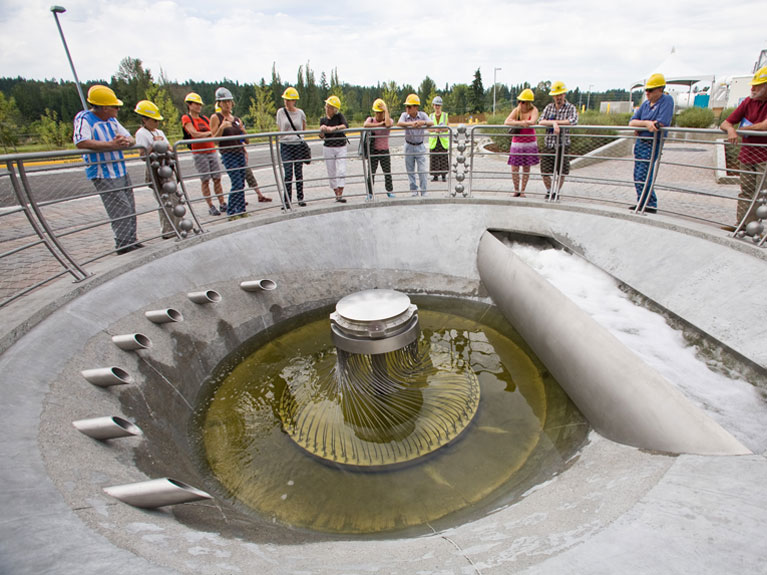4Culture Public Art’s Brightwater Project
OVERVIEW
4Culture serves as a tax-exempt public development authority for King County in Washington. Established in 2003. The authority works with the King County Arts Commission, Public Art Commission, and the heritage programs of the Landmarks Commission and is widely recognized as one of the strongest public art programs in the country. One of its most successful collaborative projects involving arts, culture, planning, and the built environment is the Brightwater Wastewater Treatment Project.

CONTEXT
In 1999, a sewage treatment facility was slated for construction on the border of two counties — Snohomish and King County. The manager of the project, Architectural Design and Mitigation Manager Michael Popiwny in the Department of Natural Resources and Parks, was supportive of including public art and proactively sought to include an artist in the project at a very early stage. The Department engaged 4Culture to facilitate a peer panel review process to select an artist. 4Culture engaged its public art advisory committee, which is composed of artists, architects, engineers, and cultural activists, was engaged in the process.
PARTNERS
4Culture, King County Department of Natural Resources and Parks: Wastewater Treatment Division, CH2MHill, MITHUN, Hargreaves Associates, Hoffman, IslandWood, Friends of the Hidden River, Turner Exhibits, flyLO, Derix Glass Studios.
FUNDING
Content under development.
PROCESS
The Brightwater design team consisted of people from five different disciplines: art, architecture, engineering, landscape architecture, and education. The first artist to join the project was Ellen Sollod, who joined the project during the siting analysis stage. There were multiple project teams consisting of engineers, biologists, and outreach staff, and each team was asked to include Sollod and to work with her at each stage. 4Culture also released a call for artists to secure two additional artists to work with Sollod. 4Culture established a peer panel review process to guide the selection and Jann Rosen-Queralt and Buster Simpson were selected to join the team. The artists, along with 4Culture, worked together to create a Brightwater Art Master Plan that was completed in 2003. The arts element was established with a central focus on “making Brightwater a community amenity and to maximize opportunities to engage the public about the importance and function of wastewater management.” The Art Master Plan identified Brightwater as an opportunity for artists to “develop sensory reminders of our region’s ethic of environmental stewardship and sustainability.” (Sollod, Rosen-Queralt, and Simpson, 2003)
The Plan identified thematic zones for integrated artwork that guided the creation of permanent and temporary artworks throughout the 70-acre area of open space in the vicinity of the treatment facility. The artists and 4Culture also prepared a companion Brightwater Art Concept Workbook that described the thematic ideas in greater detail for future artists to reference when creating works. (King County, 2016) 4Culture released invitationals to select artists to implement temporary and permanent artworks consistent with the principles outlined in the Plan and Workbook.
SUCCESS
The Brightwater project created an opportunity to integrate permanent and temporary artworks into the landscape in ways that celebrated the natural systems of the water cycle and the reclaimed water use, enhanced the natural environment, and educated the public.
- The Plan led to the commissioning of 11 artists to do temporary and permanent interpretive and conceptual projects and guided the inclusion of temporary events organized with the Brightwater Center, a local education center that has become a community gathering space, exhibit hall, and learning laboratory on the lifecycle of water, the treatment process, and the geography of the area. The projects commissioned focused on environmental issues or the treatment plant itself.
- 4Culture and the Department of Natural Resources and Parks established and maintained a good working relationship. Popiwny was very open to what the artists wanted to do, and was willing to allow a lot of exploration during the process. A strong element of the project that facilitated the collaboration was the early identification of design values by the interdisciplinary project team.
- After the three lead artists produced the Master Plan, they were kept on as lead artists to serve as mentors to the other artists who were implementing the project. The project duration was a long-term engagement for the artists and the project team — lasting 11 years from start to completion.
LEARN MORE
Public Art Collection Project Profile: Brightwater Center. 4Culture. (2016) http://www.4culture.org/publicart/collection/profile.aspx?projectid=6&cat1=Collection&cat2=Project&cat3=A-J&cat3b=
Water and Ecology: Artists Tell the Story of Brightwater. King County. (2006) http://www.kingcounty.gov/services/environment/brightwater-center/art.aspx